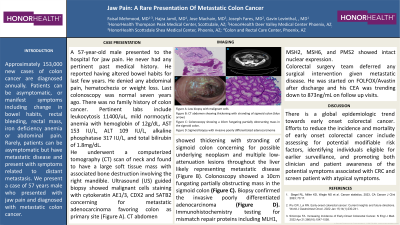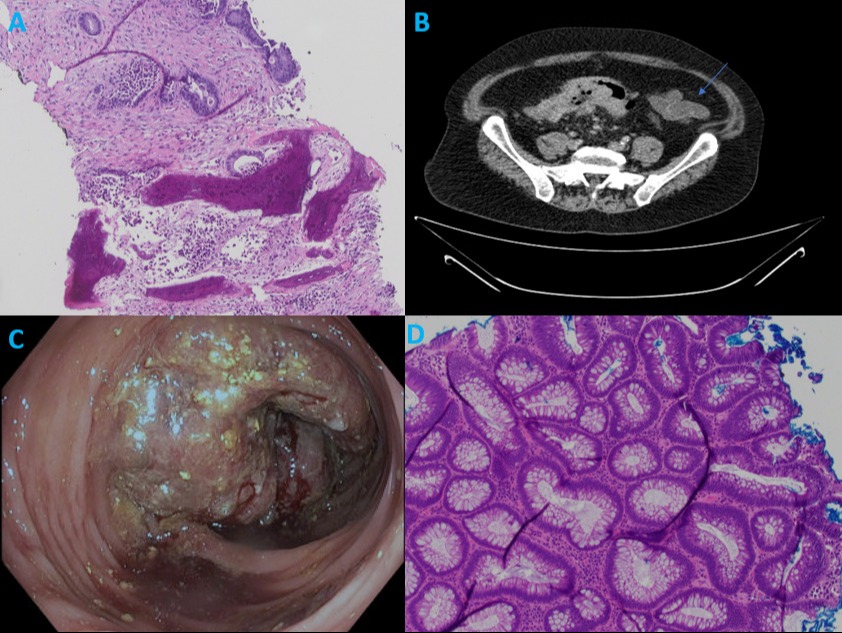Monday Poster Session
Category: Colon
P2008 - Jaw Pain - A Rare Presentation of Metastatic Colon Cancer
Monday, October 28, 2024
10:30 AM - 4:00 PM ET
Location: Exhibit Hall E

Has Audio
- FM
Faisal Mehmood, MD
HonorHealth
Glendale, AZ
Presenting Author(s)
Faisal Mehmood, MD1, Hajra Jamil, MD2, Jose Machain, MD3, Joseph Fares, MD3, Gavin Levinthal, MD3
1HonorHealth, Phoenix, AZ; 2Services Institute of Medical Sciences, Lahore, Punjab, Pakistan; 3HonorHealth, Scottsdale, AZ
Introduction: Approximately 153,000 new cases of colon cancer are diagnosed annually. Patients can be asymptomatic, or manifest symptoms including change in bowel habits, rectal bleeding, rectal mass, iron deficiency anemia or abdominal pain. Rarely, patients can be asymptomatic but have metastatic disease and present with symptoms related to distant metastasis. We present a case of 57 years male who presented with jaw pain and diagnosed with metastatic colon cancer.
Case Description/Methods: A 57-year-old male presented to the hospital for jaw pain. He never had any pertinent past medical history. He reported having altered bowel habits for last few years. He denied any abdominal pain, hematochezia or weight loss. Last colonoscopy was normal seven years ago. There was no family history of colon cancer. Pertinent labs include leukocytosis 11400/uL, mild normocytic anemia with hemoglobin of 12g/dL, AST 153 IU/L, ALT 109 IU/L, alkaline phosphatase 317 IU/L, and total bilirubin of 1.8mg/Dl.
He underwent a computerized tomography (CT) scan of neck and found to have a large soft tissue mass with associated bone destruction involving the right mandible. Ultrasound (US) guided biopsy showed malignant cells staining with cytokeratin AE1/3, CDX2 and SATB2 concerning for metastatic adenocarcinoma favoring colon as primary site (Figure A). CT abdomen showed thickening with stranding of sigmoid colon concerning for possible underlying neoplasm and multiple low-attenuation lesions throughout the liver likely representing metastatic disease (Figure B). CEA was 1666 ng/mL. Colonoscopy was done and showed a 10cm fungating partially obstructing mass in the sigmoid colon (Figure C). Biopsy confirmed the invasive poorly differentiated adenocarcinoma (Figure D). Immunohistochemistry testing for mismatch repair proteins including MLH1, MSH2, MSH6, and PMS2 showed intact nuclear expression. Colorectal surgery team deferred any surgical intervention given metastatic disease. He was started on FOLFOX/Avastin after discharge and his CEA was trending down to 873ng/mL on follow up visits.
Discussion: There is a global epidemiologic trend towards early onset colorectal cancer. Efforts to reduce the incidence and mortality of early onset colorectal cancer include assessing for potential modifiable risk factors, identifying individuals eligible for earlier surveillance, and promoting both clinician and patient awareness of the potential symptoms associated with CRC and screen patient with atypical symptoms.

Disclosures:
Faisal Mehmood, MD1, Hajra Jamil, MD2, Jose Machain, MD3, Joseph Fares, MD3, Gavin Levinthal, MD3. P2008 - Jaw Pain - A Rare Presentation of Metastatic Colon Cancer, ACG 2024 Annual Scientific Meeting Abstracts. Philadelphia, PA: American College of Gastroenterology.
1HonorHealth, Phoenix, AZ; 2Services Institute of Medical Sciences, Lahore, Punjab, Pakistan; 3HonorHealth, Scottsdale, AZ
Introduction: Approximately 153,000 new cases of colon cancer are diagnosed annually. Patients can be asymptomatic, or manifest symptoms including change in bowel habits, rectal bleeding, rectal mass, iron deficiency anemia or abdominal pain. Rarely, patients can be asymptomatic but have metastatic disease and present with symptoms related to distant metastasis. We present a case of 57 years male who presented with jaw pain and diagnosed with metastatic colon cancer.
Case Description/Methods: A 57-year-old male presented to the hospital for jaw pain. He never had any pertinent past medical history. He reported having altered bowel habits for last few years. He denied any abdominal pain, hematochezia or weight loss. Last colonoscopy was normal seven years ago. There was no family history of colon cancer. Pertinent labs include leukocytosis 11400/uL, mild normocytic anemia with hemoglobin of 12g/dL, AST 153 IU/L, ALT 109 IU/L, alkaline phosphatase 317 IU/L, and total bilirubin of 1.8mg/Dl.
He underwent a computerized tomography (CT) scan of neck and found to have a large soft tissue mass with associated bone destruction involving the right mandible. Ultrasound (US) guided biopsy showed malignant cells staining with cytokeratin AE1/3, CDX2 and SATB2 concerning for metastatic adenocarcinoma favoring colon as primary site (Figure A). CT abdomen showed thickening with stranding of sigmoid colon concerning for possible underlying neoplasm and multiple low-attenuation lesions throughout the liver likely representing metastatic disease (Figure B). CEA was 1666 ng/mL. Colonoscopy was done and showed a 10cm fungating partially obstructing mass in the sigmoid colon (Figure C). Biopsy confirmed the invasive poorly differentiated adenocarcinoma (Figure D). Immunohistochemistry testing for mismatch repair proteins including MLH1, MSH2, MSH6, and PMS2 showed intact nuclear expression. Colorectal surgery team deferred any surgical intervention given metastatic disease. He was started on FOLFOX/Avastin after discharge and his CEA was trending down to 873ng/mL on follow up visits.
Discussion: There is a global epidemiologic trend towards early onset colorectal cancer. Efforts to reduce the incidence and mortality of early onset colorectal cancer include assessing for potential modifiable risk factors, identifying individuals eligible for earlier surveillance, and promoting both clinician and patient awareness of the potential symptoms associated with CRC and screen patient with atypical symptoms.

Figure: Figure A: Jaw biopsy with malignant cells
Figure B: CT abdomen showing thickening with stranding of sigmoid colon (blue arrow)
Figure C: Colonoscopy showing a 10cm fungating partially obstructing mass in the sigmoid colon.
Figure D: Sigmoid biopsy with invasive poorly differentiated adenocarcinoma
Figure B: CT abdomen showing thickening with stranding of sigmoid colon (blue arrow)
Figure C: Colonoscopy showing a 10cm fungating partially obstructing mass in the sigmoid colon.
Figure D: Sigmoid biopsy with invasive poorly differentiated adenocarcinoma
Disclosures:
Faisal Mehmood indicated no relevant financial relationships.
Hajra Jamil indicated no relevant financial relationships.
Jose Machain indicated no relevant financial relationships.
Joseph Fares indicated no relevant financial relationships.
Gavin Levinthal indicated no relevant financial relationships.
Faisal Mehmood, MD1, Hajra Jamil, MD2, Jose Machain, MD3, Joseph Fares, MD3, Gavin Levinthal, MD3. P2008 - Jaw Pain - A Rare Presentation of Metastatic Colon Cancer, ACG 2024 Annual Scientific Meeting Abstracts. Philadelphia, PA: American College of Gastroenterology.
